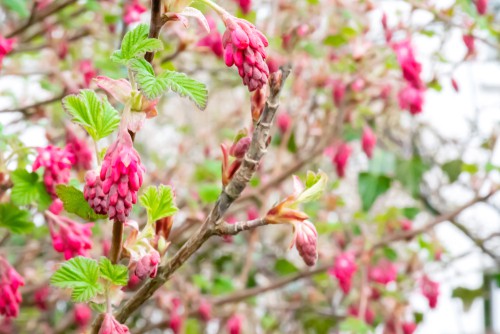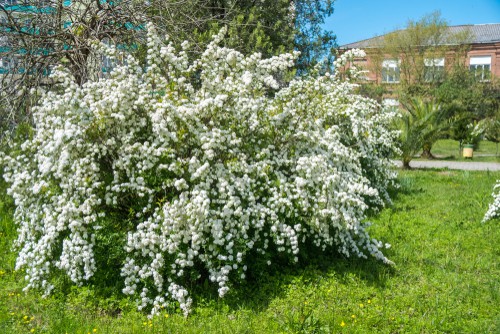Last updated on March 6th, 2022
Our site is reader supported, this means we may earn a small commission from Amazon and other affiliates when you buy through links on our site.
If you are looking for shrubs that flower early in the season, shrubs that bring about the start of the new flowering season, then you want one of these top 11 shrubs for spring interest.
With each of these, you can cultivate something magnificent, have something that offers beautiful flowers mixed with vibrant foliage that indicates the start of spring year after year.
With so many colours available there is sure to be a plant that fits well into your garden theme, from the yellow Hamamelis (pictured below) to the fiery red new foliage and white draped flowers of Pieris Forest Flame we have lots of different plants to create garden interest.
1. Hamamelis mollis – Witch Hazel

Witch Hazel is a deciduous shrub that provides fragrant, bright flowers throughout the winter and is one of the most maintenance-free flowering shrubs that you will ever find. The flowers, when in bloom, look like fiery embers against the bright winter sun. Hamamelis will grow most prolifically in full sun or in partial shade depending on how hot it gets where you live. This shrub is also tolerant of alkaline or acidic soil, so it will grow just about anywhere. You will also be pleased to know that this shrub is resistant to almost all pests and diseases.
If left to its own devices it will reach incredible heights at full maturity, however, you can keep it in check by pruning it annually after the blooms are finished. You want to prune before the summer starts so that the buds for the following year have an opportunity to develop.
One of the more unique aspects of this plant is that it actually requires a cold winter chill in order to obtain full flowering in the spring, which makes it perfect for British gardens. It’s also worth noting that there are a few varieties and some have red or orange flowers but yellow is the most popular.
2. Forsythia

Forsythias are deciduous flowering shrubs that bring to your garden vibrant yellow blooms in the spring and these also attract butterflies and bees. They will grow quite tall, much taller than they grow wide, which makes them ideal for situations where you want a border or a centrepiece for your garden. The flowers actually precede the leaves, meaning you get beautiful blossoms without any leaves interfering in your view.
Forsythias are fast-growing shrubs and they will attain an upright arch form. They bloom first in the early spring and provide you with little else for the remainder of the year, which is why it is best not to plant them on their own but rather to include them in an otherwise large garden full of late spring and summer flowering plants and shrubs.
Forsythias grow best if they are in full sun, so you want to find an area in your garden that gets at least six hours of direct sun. Anything less than that and the Forsythia will not produce as many flowers as it could. The soil must be well-drained and they will need to be watered occasionally.
3. Pieris ‘Forest Flame’

The Pieris is a broadleaf, evergreen shrub that grows tall and wide, but it’s also great for growing in pots where its size can be restricted. It provides all year round interest because against the backdrop of the mature green foliage, new growth is red and this slowly fades to creamy pink before turning green. At the beginning of spring, you will get bead-like flowers that open up to provide you with further garden interest. Its ‘Forest Flame’ name derives from the eye-catching new foliage that is red in colour.
As spring continues it will manifest in the form of small bell-shaped blooms or urn-shaped blooms. These grow very well as shrubs, serving as an informal hedge and you can choose to plant them individually or in a small group. With these plants, they need rich acidic soil so it is important that you test your soil and amend it at least two months prior to planting.
When planting new Pieris shrubs, do it between June and September and make sure you dig a hole that is slightly larger and deeper than the pot it was supplied in. Water it daily until it settles and shows new signs of growth, after which, water only enough to keep the soil moist. As the plant establishes itself in the spring you can cut off the flowers when they have finished and prune them to your desired size and shape.
4. Azaleas – Evergreen and Deciduous

You will find that you get varieties of Azaleas that are deciduous and those that are evergreen, both of which are perfect spring-flowering shrubs. The Azalea comes in so many different varieties that you can choose from pink, white, burgundy, red and even coral coloured flowers. There is very little work required to cultivate Azaleas but a big reward.
If you are looking for early spring flowers but your space is small, a dwarf variety is best. Alternatively, if you have a large space you want to fill, the Formosa varieties are a wonderful choice. Once you choose the plants of your liking you need a location that offers morning sunlight and afternoon shade or at the very least filtered light. Full exposure to the sun can cause stress on your plant and leave them susceptible to pests.
They require well-drained, acidic soil so if you test your soil ahead of time and make any necessary alterations over the course of two months prior to planting your new Azaleas. When they are first planted you will need to soak the soil two or three times per week and only they are established you can decrease the frequency with which you water to maintain moist soil. The smaller varieties are also great for planting in pots.
5. Daphne odora – Gold-Edge Winter Daphne

With this variety, you can enjoy pink flower buds that, as they open, convert to white and expose a sweet fragrance during the winter and early spring. The foliage is green with yellow margins and this is where the Gold-Edge name derives from.
These plants work well when planted against walls or near patios where the fragrance can truly be appreciated, not just by you, but by any visitors. They produce small, tubular flowers followed thereafter by bright berries. The plant itself is rather compact with dark green leaves boasting a yellow edge. It works best to fill an area that is sparse and needs larger bushes.
6. Viburnum tinus

The ornamental bush has bright green, leathery foliage with eye-catching flowers that come in the form of white clusters and these are followed by blue berries. The buds that you receive will start off as a pale pink shade in the middle of winter and manifest throughout the beginning of spring in the form of fragrant clusters that reach between 5 and 10cm in size.
These clusters offer a great deal of nectar so they will attract bees and butterflies to your garden throughout the season. The glossy green leaves, contrasted by the metallic blue coloured berries make this plant an excellent choice for low screens. It is a wonderful asset to have during the middle of winter, especially when none of your other plants are in bloom. It can reach up to 240cm in height and 180cm in width so while it doesn’t require regular pruning, you may need to cut back some of it to maintain the shape you want.
7. Kerria japonica – Japanese rose

The Japanese Rose is a deciduous flowering shrub that produces yellow flowers in the spring. The bark and branches are just as attractive a feature as the bright yellow flowers, which make it the perfect addition to any garden in need of a little colour come the end of winter or the beginning of spring.
The branching pattern goes out vertically and horizontally, with smaller branches radiating off of the main branch in every direction. The bark itself takes on a green to yellow hue. This is a very shade tolerant shrub so it is perfect for any garden region that is partially shaded. In addition to the attractive branches that will give you an interesting visual across your winter landscape, it is also very tolerant of different pH levels so you don’t need to do much to change the soil you already have.
Not only does the Kerria japonica indicate the first signs of spring with its first round of blooms, but it also gives you a second round of flowers later in the season so that you can enjoy the colour time and time again.
8. Cytisus ‘Lena’

This shrub has beautifully designed flowers that manifest along the length of a single branch bringing to your garden clusters of rich velvety red for the front petals and beautiful peach shades of yellow, pink and light orange along the remainder of the flower.
The slender green stems hide the tiniest of leaves and the dense clumps of the lemony yellow and ruby red flowers make this plant perfect for hedges and screens. It is a well-behaved hybrid shrub that will tolerate different soils and requires very little maintenance and care. It does need full sun and once it is fully established it only requires occasional watering and light pruning to keep it at your desired height.
9. Ribes ‘King Edward’

If you desire hanging clusters of flowers rather than flowers that bloom along the length of different stems, then this is the shrub for you. The flowers have a rich crimson texture to them with a great deal of visual variety because they produce tiny flowers along the length of a panicle, similar to those you see on panicle Hydrangeas.
Beyond that, there are bluish-black berries favoured by many birds. This plant requires partial to full sun, and because it flowers in spring it will add vibrant pink shades to your garden when not much is flowering. You can use this shrub to create a privacy hedge.
10. Spirea ‘Bridal Wreath’

Taking on a more unique shape, the Spirea ‘Bridal Wreath’ is a medium-sized deciduous shrub that has tiny flowers on it. When you look closely at a single branch you will see that the flowers themselves grow off long thin stems that all shoot from the branch itself, which is what creates the appearance of a bridal wreath.
During the spring, you will get an abundance of white flowers and when autumn comes around the leaves will change colour. You could literally cut off a portion of the flowers and stick the branch in a bouquet, floral arrangement in your home or even slide it into your hair allowing the array of tiny white blooms to fall where they may.
This plant is well suited for regions where deer are a problem because it is deer resistant and as an extra bonus it does attract butterflies too. It needs to be grown in an area in your garden with well-drained, moist soil where it can receive full sun. Be sure to give a great deal of space in between multiple bridal wreath plants because they can grow to such a size that they block out the light from one another.
11. Camellia

These are flowering, shade-loving shrubs that produce many different flower colours, ranging from light pinks to rich rubies to white and cream. They will bloom during the winter and early spring, which adds a bit of cheer to any garden that might otherwise be lacking in colour.
The flowers themselves have an abundance of petals so close together that it almost looks unreal. One variety, the Bella Rossa, produces sets of five petals that, as they grow, get larger and are followed immediately by a new set of petals on the same flower, such that you could have a central bud from which the petals are originating that opens slowly to smaller sets of five against larger sets of five, and so on and so forth, 10 or 12 layers deep, creating a beautiful three-dimensional and geometric pattern for your garden.
Camellias do grow quite large, so allow plenty of room for them to grow.
Last update on 2025-07-03 / Affiliate links / Images from Amazon Product Advertising API













